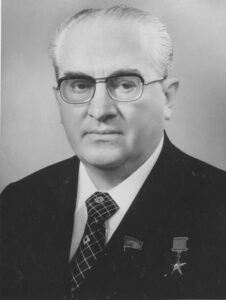
They Call Him the Butcher
Twenty-five years have passed, but I still remember Andropov’s false smile, his cold gray-blue eyes that obviously had hypnotic power. Those were the eyes of an inquisitor; you immediately realized that he could either smile upon you or destroy you. That was a man who perfectly understood what was going on in reality. But until the last moment he pretended with me, and the prime minister, and others, that everything was all right, as usual. Even pirates attacking a ship hoist a black flag. Andropov was a real cynic. For Hungarians Andropov is a symbol of terror that followed the Soviet intrusion. He reduced Hungary to the silence of a cemetery. He deported thousands of Hungarians into Russia and executed hundreds of defenseless young people. — Major-General Bela Kiraly

He became known as the Butcher of Budapest, although in later years before his death he managed to bury that reputation a bit and even have people see him as a bit of a reformer within the Soviet system. He spent his career in the KGB, an unusual place for a reformer to be planted.
“Let the gullible fools believe you want to perfume your communism with a dab of Western democracy and they will clothe you in gold,” Andropov reportedly said to the Romanian General Ion Mihai Pacepa.
Yuri Vladimirovitch Andropov was the Soviet ambassador to Hungary when the Hungarian Revolution broke out in 1956. From the beginning he was a staunch advocate of military intervention – even as the Soviet Presidium was meeting and leaning toward negotiating with the new Hungarian Government of Imre Nagy.
As the revolution unfolded, Andropov watched out his window as members of the Rakosi/Gero government were hung on lampposts and tortured. He was horrified at the realization that even the might of the Soviet system was not invulnerable to revolution. The mindset created by witnessing these events became known as Andropov’s “Hungarian Complex” – the belief that only armed force could save socialist states at risk from internal dissent. He was to operate from this belief for the rest of his life.
When the Red Army returned to Hungary and invaded Budapest on 4 November 1956, everyone understood it was the end. Janos Kadar was the leader selected by Moscow to take over the Hungarian government, but it was really Andropov behind the scenes directing the post-revolution clean-up. He set people to identifying rebels from photographs taken by the international photographers who had been so caught up in the excitement of a nation attempting to assert their independence. Those photos, viewed with such excitement throughout the world, turned out to be the vehicle of retribution.
After the revolution was ended, 229 young Hungarians were executed for participating. There were 22,000 imprisoned after show trials, and more than 200,000 refugees spread out from the Hungarian borders. These were not small numbers, and Andropov was behind them all.
“This man was definitively the highest echelon in making decisions about who and how many people were to be executed. I’m sure he was given absolute power in the matter of punishing revolutionaries. So the epoch of terror in Hungary was the epoch of Yuri Andropov’s terror. It is bound with his name forever,” Gyorgy Heltai – Deputy Foreign Minister of the Nagy Government
To read our series on the Hungarian Revolution, click here.
- November 9, 2020
- History
